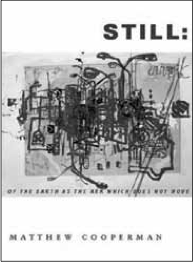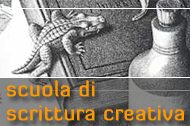
« indietro
|
|
MATTHEW COOPERMAN, Still: Of the Earth as the Ark Which Does Not Move, Counterpath Press, 2011, pp. 120.
|
It has come to be a truism that all writing is about writing and that any literary text is, as Roland Barthes insisted in Death of the Author, «made of multiple writings, drawn from many cultures and entering into mutual relations of dialogue, parody, contestation, but there is one place where this multiplicity is focused and that place is the reader, not, as was hitherto said, the author». Of course, by now such a claim is beyond being a well-established theory and has become a fundamental convention. Still, it may be that we continually need to be reminded of the fact that no text, or person for that matter, is a unified whole but is a collection or series of parts that are perpetually reworking and repositioning themselves, depending on moment and context. To not see that is to always be in the grip of an illusion of permanence and settledness that forecloses discovery and possibility. Matthew Cooperman’s third collection of poems Still: Of the Earth as the Ark which Does Not Move in essence foregrounds that condition of being an evershifting constellation or gathering of parts in ways that are as ambitious as its title indicates. More than a hundred pages in length, the work is a serial investigation of contemporary form that makes apparent through lists and indexes, quotations and erasures that perception and attention is always a process of suturing together disparate parts. Rather than being a collection of discrete poems, the book, written over the course of a decade, acts as a single, integrated text, but one that always exposes the fact of its having been assembled. To be clear, Still is not one long poem. As the book’s list of acknowledgments testifies, many of the sections have appeared separately in various journals and magazines. Yet, each poem is so tied to the overarching structure that clearly readers are meant to see almost simultaneously how the sections hold together and how they also push and pull against each other, trying to wrest themselves free. In this way, Cooperman’s poetic structure enacts the complex experience of living within a democratic system. The poetics of Still allegorizes what it means to be a democratic subject.
Cooperman employs many devices to establish the foundation within which sections are complexly interconnected. For instance, each poem or section is framed with the word still, as in «Still: Fighting», «Still: Reality», «Still: Demons». The word ‘still’ suggests both ongoing (as in yet) as well as a film still. The poems each deconstruct the materials and references that shape an understanding of a moment. Using the trope of the film still as a way allows Cooperman to break down a perception of an action in a moment of time into constituent elements. The poems consistently cut against narrative conceptions in order to reveal the conceptual elements that are always in play in any experience. Cooperman, in a manner of speaking, reveals the html code of the act of perceiving. That is to say, in Still any moment, every action is a text, and like any literary text is comprised of an almost unending set of codes and significations and references, like a string of programming code. Take for example this excerpt from «Still: Howling»,
Cause: hunger, as if there were something else, the urge to eat the need to shit. And yet play, lamentation, the joyous body. The wolf sets out to mark the dying day like an actual bone. No need for our time, they have their own time
Communication: vocal, postural, olfactory. «Their pelage is like a sign... » Camp: Lobos (family fun! picture day! tracking! hats! biofacts! 301c opps!) Journal: Wild Canid Center Review, «Providing an alternative to extinction»; Hominid Studies, «Good humans make good labors»; Howling Wolf, «Letters to Presley»Wish List: two-drawer fire proof file cabinet, plaster of Paris, bleach, fresh meat, heavy duty blankets, rawhide bones for games
Report: very multicultural, fourteen Mexican grays, six reds, one Iranian gray, six South American maned, three Ethiopian reds, two swift foxes
The poem makes use of these long prosaic lines that suture together a series of notes, ideas, claims, and references in the form of various kinds and sources of discourse. This network of languages is what forms a sense of multiple, confederated selves.
We hear in Barthes’ suggestion that a text is a tissue of quotations, the implication that a text has no center and thus it does not build and fall. Cooperman has created a form that does not exactly move since there is no narrative development or even logical goal. The poem’s lines and ideas accrue rather than develop towards some specific goal. We are left then to experience how things gather rather than letting the mind race ahead to the goal or conclusion. The sections of Cooperman’s Still are hard to quote briefly and concisely – the poem wrestles with the fact that it cannot offer a stable center from which its authority can be said to flow. Still works against closure and stability so that the texts mirror the process of experience itself. Or as Cooperman writes, «I questions all / myselves occluded sum / disguise a record / of our eyes».
In many ways, this excerpt teaches us how to read Still. We might unpack its argument this way: A singular conception of an «I» works to question the sum of all the selves that each person is. And the «occluded sum» that is the gathering of selves – the beliefs, thoughts, values and perceptions we have – also flows between each of us and any direct, unmediated experience of the world.
Cooperman’s Still directs our attention towards the very means and mechanisms of how we experience our own experiences. Indeed, Still reveals its vision and ambition at every turn because Cooperman believes so much depends on our recognition that thinking is shot through all the ways we might encounter the world, other people, and ourselves. As he writes in «Still: Here», «and in the end, I’m still here, I am always in the book, a somewhere I am, traveled, traversed, the amount of space I use I am, I seem to move around». This sounds less like description and more like a melancholic intervention – devout and chastening, by turns – by which we might begin to or- der the respective books of our individual days, and reminds us why Cooperman’s Still has so much to teach us. About our own operating systems.
(Richard Deming)
¬ top of page







